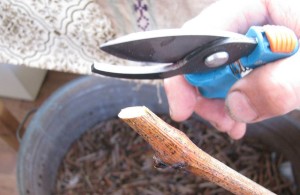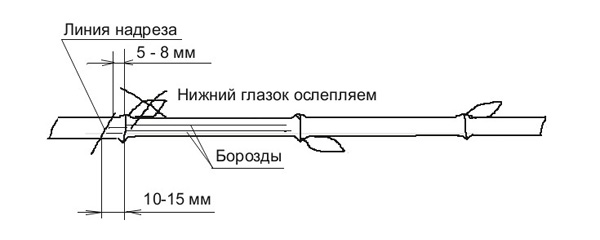How to prepare grape cuttings in the fall to get good planting material?
The issues of grape multiplication are an important component in the cultivation of this horticultural crop. At the same time, it is possible to prepare cuttings from existing varieties, which you really like by their taste. This article will be devoted to exactly how to prepare grape cuttings in the fall and properly prepare them in order to obtain high-quality planting material.
Content
The choice of material for cuttings
In order to get high-quality planting material, cuttings must be prepared in the right way. One of the fundamental steps in this matter is the choice of material.
The material should be taken in the fall. But, if you are selling them, then the procurement can take place throughout the year. In any case, you need to know exactly how many seedlings you need, so that later you do not engage in attaching unnecessary seedlings and do not throw them away.
There are certain requirements that are placed before the material for harvesting grape cuttings:
- the grape bush bears fruit well;
- the bush must be completely healthy. It should not have traces of diseases, fungal infections, mechanical damage;
- the bush must grow in the same area in which the seedlings obtained from cuttings will be planted;
- the vine must be of normal growth. It should not be withered or withered.
You can choose the desired bush in summer or early autumn. It is during the summer, observing all the grape bushes, that the strongest and most fruitful bushes can be identified.

This method is called mass selection. It allows methodically, from year to year, to select bushes according to such important criteria as yield, health and growth intensity. The vines have been observed for three years. After that, those bushes are distinguished that have borne fruit well for three years in a row. At the same time, they need to be marked somehow (for example, with a metal tag, colored tape, oil paint, or simply not to remove a bunch of fruits). This is done in order not to forget and not lose sight of the selected grape bush.
Remember that the growth and taste of the cuttings reflect the same parameters of the mother bush.
Blank
After you have decided on the source material, you can proceed to the direct harvesting of cuttings.
Usually, this process is carried out in the fall (in October) after leaf fall. But you can find information that grape cuttings were harvested in winter (at the beginning of December). But this is permissible only when the winter is mild and severe long-term frosts have not yet arrived.
If you live in an area characterized by early and prolonged frosts, harvesting cuttings is possible only in early autumn. In this case, the readiness of the vine is determined by the ease of separation of the leaf from it. The vine is ripe enough when the leaf stalk is easily peeled off with a cork layer.
It is allowed if there were single frosts before the cuttings were cut in the fall. In this case, the future shank will be hardened for overwintering and will accumulate a sufficient amount of nutrients (especially carbohydrates).
Slicing
After the bush has been selected and the vine is mature enough in the fall, you can start cutting the cuttings.
Rules for cutting grape shanks:
- only fruit shoots can be cut;
- rather long cuttings must be cut - about 140 cm, although their length is allowed from 50 cm;
- vines should be relatively straight;
- the color of the cut shoots should be uniform, without blotches;
- the width of the selected vine should not be large enough (no more than 8 mm). If it is larger, then it is no longer a fruit vine, but a fat shoot. Such a shoot will not be able to produce a strong and fruitful cutting and sapling;
- the stalk should also not be very thin (less than 5 mm). A smaller diameter will not allow the cutting to survive the winter normally;
- they should be free of stepchildren, excess bark, antennae and leaves;
- a prerequisite is the presence of two or three living and healthy buds on the cut cuttings;
- growers recommend cutting the shanks from the middle of the vine;
- the handle must have at least five internodes (the recommended number is from six to eight). But experienced gardeners believe that three or four internodes are enough;
- cut off only with clean (to prevent infection) and well-sharpened garden shears or pruners;
- cutting is carried out from the bottom up;
- the cuts should be straight and with smooth edges. To do this, they need to be cut obliquely.

Scheme for cutting grape cuttings
Compliance with the above rules will allow you to carry out the harvesting of cuttings in the most correct way and in the spring to get the desired result in the form of perfectly sprouted grape seedlings.
Disinfection
Cuttings can be easily spoiled if you have not carried out disinfection treatment throughout the day. If for some reason you cannot carry out this manipulation, then the vines need to be dug in or wrapped in a plastic bag.
Not all disinfectants are suitable for grapes, otherwise, when using them, you can get a decrease in the quality of the future planting material. These disinfectants include, for example, some pesticides.
Cut cuttings can be fumigated with insecticides, fungicides and sulfur dioxide (either fumigation or a creamy mash with the addition of a mixture of various pesticides). Methyl bromide and fumigant fostoxin are also used.
Another method of decontamination involves placing the slices in water for two days and then keeping them in a plastic bag for four days. Then they are placed in an organophosphate pesticide solution. After that, the shanks are placed in a plastic bag for another day.
The simplest way of disinfection is to soak the cuttings in water for a day, followed by treatment with an intense pink solution of potassium permanganate.
A 3% solution of copper sulfate is also used (30 g of copper sulfate is diluted in 1 liter of water). After that, the shanks are soaked with paper towels and laid out on dry paper to dry.
Storage preparation
After you have cut the cuttings and disinfected, they need to be grouped into piles depending on the variety.
The resulting cut material is folded with the upper ends to the upper and the lower ends are trimmed. After that, they are tied with wire into bundles. One bunch can contain from 20 to 25 cuttings. The bunches are marked with labels, which indicate the variety and time of cut, as well as the purpose (sale, planting and its place). The labels should be made of a material that will tolerate the storage juice (plastic, metal, or foil).
The bundles are then wrapped in plastic bags and sent to a storage location.
Video "Harvesting grape cuttings"
In this video, you can visually view all the necessary stages of harvesting grape shanks.
Following the above recommendations, you can get good-quality planting material, which in the future will provide you with new healthy vines.
